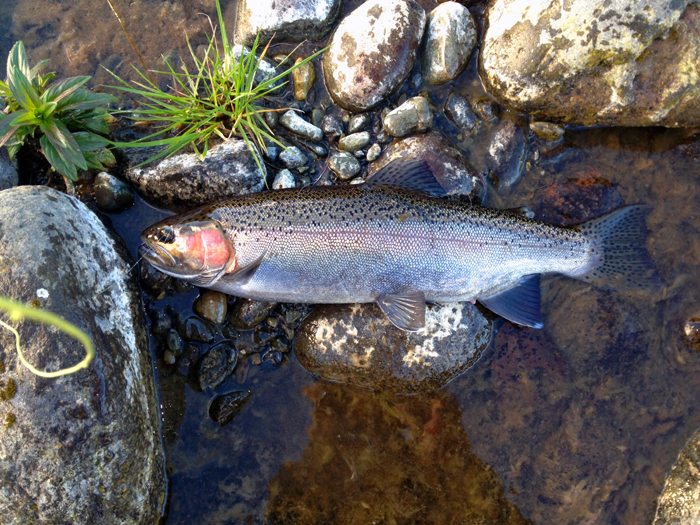 '
'Information Page.
Tongariro trout.
Followers of my BLOG will know that my pal Alan in New Zealand is a keen fly fisherman. Despite what you may have read in the past the fishing in NZ rivers is no easier than anywhere else and often it resembles fishing your fly on a rolling leger (the weight being a second heavy fly). Alan describes the technique much better than I can following his recent family holiday on the Tongariro river.:-
Hi Mike,
As promised, please find below a more detailed summary of our Turangi sojourn.
Day One
I left Auckland alone at 8.30 am on a beautiful, crisp sunny spring morning. One of those mornings that truly makes you glad to be alive. First stop was Whangamata to collect Hazel for the journey to Turangi. Sandy (Alan's wife) and the boys were making their way down later in the day so we formed the advanced guard. The trip down to Turangi was painless in the settled weather and we finally arrived at our rental accommodation (or bach) around 2.30 pm. I unpacked the car as fast as possible, gulped down a cup of tea and a slab of fruit cake, shot into town to get some groceries and collect a fishing licence en route back to the bach. By the time I'd done this and set up my fishing gear it was 4.15 pm. Just enough time for a quick flick before dinner.
I opted to fish in a calf to knee deep riffle on the Tongariro almost directly behind the bach, just because it was close and allowed me to optimise fishing time. I'd decided in advance to use a #12 chestnut wire bead head bomb. The problem was what to attach to the 12" of nylon that was tied onto the bend of the bomb. Remembering that I'd done well with a #14 bead head green chenille flash nymph previously in this spot I knotted one onto the point. Three casts is all that it took to lose the fly on a hungry, weed covered rock in the middle of the riffle. Scanning my fly box for a replacement I noticed a #14 soft hackle orange epoxy coated wee wet fly ribbed with yellow wire and attached it to the point (see Tongariro flies photograph). Originally I started fishing the fly combination directly upstream to ensure dead drift but soon tired of the endless mending and line retrieval. In despair I started to cast perpendicular to the flow, through in an upstream mend and then allow the line to drag in an arc back to the shore as is standard practice with wet fly fishing. This is a decided aberration from standard nymph fishing practice on the Tongariro and would have been met with guffaws from any watching anglers.
The very next cast I thought I had a touch which piqued my interest. A couple of casts later, as I was drinking in the surroundings and day dreaming, the line stopped almost at the end of the drag and positively fizzed through the water as a feisty 3 lb. hen headed off upstream. I was hooked up and barely in control. The trout charged around the margins snaking and slipping between the boulders and weed almost as if it was scared to take on the main flow. This went on for a few minutes until eventually the hen tired enough to be beached, photographed and gently released (see image First trout of trip). What a start! 15 minutes to get off the mark and what a honey of a fish. The successful fly was the soft hackle wee wet on point.
I fished on with renewed vigour but within 10 minutes two young anglers barged into the head of the riffle 30 metres upstream and put paid to any further sport. By now my mobile telephone had confirmed that the family had arrived from Auckland and dinner beckoned so I adjourned back to the bach for an aperitif.
Day Two
Another stunning day in paradise. A chilly dawn heralded a fine cloudless day with sun streaming through every pane of glass and curtain gap in the bach. Too cold to leave a deliciously warm, comfortable bed so I waited until 8.00 am before getting up. I gulped down a quick breakfast of cereal and toast washed down with a steaming cuppa. I opted to revisit the scene of yesterday's triumph and was casting the same fly combination into the riffle by 8.45 am. Nothing came to the fly in the first 20 metres which took almost as many minutes to cover methodically. By then I was into an upstream casting rhythm and operating on automatic. Pitching the fly directly upstream and watching the fly line for any deviation as I stripped in the slack to keep pace with the flow.
I then noticed a nice current seam flowing between two larger boulders and flipped a cast into it. The line travelled about three feet before it stopped abruptly. The water erupted as if a large rock had been dropped in from above. A decent trout had monstered the fly and headed off into the main channel en route back to the lake. Unfortunately the trout was a 2.5 lb. spent hen and, due to its recent exertions, did not take long for the 9'6" 8 weight Scott fly rod to subdue. Again the soft hackle wee wet had done the damage. Inspired by this success I continued to prospect upstream and with 10 minutes was again into another trout which was biding time in the margins. This fish was in much better condition and also steamed off deliberately into the main flow. I struggled originally to gain control of the loose line and come up tight on the trout but fortunately the wee wet was well set in the scissors and soon a 3 lb. jack was flapping in the shallows. By now it was "coffee o'clock" so I wound in and headed back to the bach, best pleased with my morning's work. Three fish in two short sessions, all on the wee wet fly fished in tandem with a nymph bomb.
I returned to the river in the late afternoon for an hour with Hamish to help him get his eye in. We focused on head of run where I'd been successful earlier but it was as bare as Mother Hubbard's cupboard. No touches.
Day Three
Another "ditto day" in paradise. Chilly, gloriously fine and calm. Once again I struggled to get up but was put to shame by my tardy fishing companion who finally stumbled out of bed for breakfast at 8.45 am. Once Hamish was up, I took the cattle prod to him and we were in the car en route to the Stag pool by 9.15 am. Hamish was busting to fish the Stag as he'd had success there last December. As we walked through the bush I told him he had first lash at the pool and that I'd spot for him. Bad mistake. We got to the river bed and he was off, bouncing across the beach ball sized boulders like a nanny goat on heat. He was flipping his tandem nymph rig into the head of the pool before I'd had time to catch breath and wipe the steam off my polaroid's. Unfortunately there did not appear to be anything sitting out in the shallows so I opined that the run may already have been fished and headed off downstream to see what I could find.
The mid-section of the run was punctuated by a riffle and it looked inviting, albeit with no fish visible. I carefully crept out across the shallows and lobbed my favourite fly combination upstream. Nothing doing for the first 10 casts and then the same outcome for the next 10. I was using the same fly selection as yesterday and figured that I may not be getting deep enough. To get around this I added a Toobie tube above the bomb and inserted two small tungsten balls into the tube. Second cast into the riffle and the fly line stopped like a car hitting a wall. I struck hard and was into a solid fish. Heavy and uncontrollable. It took off into the deep water and pulled the fly line under a submerged branch. This made it almost impossible to keep in contact so I sprinted upstream to free the fly line and fortunately it came free with a twang. The fish was still on but was proving a real handful. I just could not seem to get any sort of control. It either was a huge fish or it was foul hooked. Hamish and I were hoping for the former but after another 5 minutes of relentless side we found that it was the latter. A 3 lb. spent hen foul hooked with a wee wet cleanly in the vent. No wonder it took a long time to control and land. We'd only ever caught two fish in this pool, both foul hooked!
By now Hamish was keen to move on. We'd spotted some leviathans in the Admirals Pool from the car park and he was busting to have a shot at them. We sped through the bracken and scrub on the river bed like men possessed and were panting hard by the time we reached the Admirals. Again I opted to let Hamish have first "dibs" but the trout had seen it all before and neatly side stepped his offerings. He tried adding additional weight (if the bomb had hit a trout it would have been instantly concussed) but this made no difference at all. Tiring of this after 20 minutes we decided to head downstream to find some shallower water. Hamish again headed off at pace while I followed at a more sedate rate.
By the time he'd got to the end of the riffle run below the Admirals pool I was about 50 metres away, scanning every likely holding lie for tell-tale black smudges. Then I saw them. A pod of 6 - 10 fish finning in a lie behind a reasonable boulder. I unhooked the flies from the keeper hook and lobbed them into the flow about two rods lengths upstream of the lead fish. The flies drifted downstream, the fish moved towards where I thought my flies were, the line stopped as I strip struck and I was in. This fish was a 3.5 lb. fresh run hen and was a jumper. Six times it leapt into the air in the heavy rapids and the last jump was followed by a surface porpoise of about 10'. It took some time to get this trout under control and in the shallows as it seemed again to be bigger than it actually was. Finally Hamish swept the net under it and then we discovered that it was neatly foul hooked in the near side pectoral fin by the...wee wet. I'm picking that it actually took the bomb, dislodged it when it was jumping and unluckily fell on the trailing point fly. It swam away strongly when release none the worse for its exertions.
I then set up Hamish to target the remaining fish using 0.9 gram Hares Ear bomb and a #14 bead head green chenille flash nymph. He hooked up within six casts and lost the fish when trace broke. In his excitement he forgot to let the fish run and the nett result was the trace snapping with an audible whip crack. We persevered for a while trying to hook up again but nothing was interested. I had another go and hooked up a bankside bush. When I reeled in to recover the snagged back cast I found another six new flies in the bush. Definitely my lucky day. Two foul hooked trout and six flies for the morning. By now it was lunch time and we were both keen to get back to the bach for a snack so we packed in and headed off.
Later in the afternoon I fished between 3.30 - 4.30 pm with Sandy in the Swirl Pool. There were four anglers in main run so I left her to it. I systematically fished both rapids into Swirl and hooked up on a dead weight in the main rapid. Imagine my surprise when I played out the dead weight to find that the wee wet had snared a McLean aluminium landing net in excellent condition. It could not have been in the run for more than a couple of days. What an ending to the day! Lucky or what?
Day Four
Yet another stunning day in Turangi. Again a chilly start accompanied by still conditions and radiant sunshine. A few cotton ball clouds punctuated an otherwise clear sky. Ideal conditions to nymph fish the Tongariro. Hamish was keen to fish the Kamahi pool as it looked glorious from the pool above yesterday. We set off to walk to the Kamahi at around 8.50 am. The track to the pool was a revelation. Bush fringed on one side of the track and verdant paddocks the other. Away in the distance stood the majestic Kaimanawa range, framed in sunlight. It took around 35 minutes to get to the pool and it screamed trout. A deep head section with an accompanying eddy which flowed into a long glide and shallow tail. Multiple black smudges could be seen holding station on the bottom, perpendicular to the surface flow. It would be tricky to get flies down to these fish as the surface current would drag the nymphs away before they got down deep enough to be carried to the waiting trout. Long story short we fished between 9.45 - 12.15 pm in the pool without so much as a touch. We even resorted to heavy bombs (up to 1.9 grams) but still couldn't reach the bottom consistently. The conflicting currents were a nightmare. In desperation I also tried an extra fast sink polyleader with smaller bombs but still could not get down.
Just as we were about to leave several trout moved into margins and held station. By now I had re-tied on my #12 chestnut wire bead head bomb and attached a glass bead roe imitation at point. I quickly slipped in behind them downstream and pitched the tandem nymph rig into the current seam about two rod lengths above them. The nymphs plopped in and sunk quickly to the bottom. One of the trout shot sideways to intercept them, I struck and came up solid. Yeeha! The trout took off like it had been scalded and headed deep under the far bank. There it continued to head south back towards the lake. I managed to turn its head before it left the pool and from then on we played “tit for tat” for 5 minutes, neither of us wanting to concede. Eventually the immense power of the 9’6” Scott # 8 weight tipped the balance and I was able to draw the fish into the shallows for Hamish to net. The fish weighed a click over 4 lbs. and joined us for the long walk home where it ended up it the smoker. Delicious! In case you were wondering it had taken the glass bead roe fly at point. (see image One for the Smoker).
Day Five
The great weather had to come to an end eventually and when we awoke the next morning it was overcast and drizzling intermittently. Hamish and I set forth from the bach at 8.45 am to target the riffle that had been so productive to date, sensing that rain would soon drive us home. I knotted on the ubiquitous #12 chestnut wire bead head bomb and soft hackle orange epoxy nymph combination. Within minutes of starting a fish swirled at the flies in the margins, I struck and was on. On and off. “Bother” I uttered through clenched teeth. Nothing came to the flies in the next 20 minutes so I helped Hamish target fish sitting high in run. You could see them holding tantalisingly on the gravel in the knee deep water. Hamish was using 0.77 gram pheasant tail nymph bomb and Mallard & Claret. Eventually he managed to hook a fish but, just like me, it was a short encounter as it dropped off. The air was blue. Could be one of those days I opined sympathetically. The response was unprintable.
After about 10 minutes it started to rain more determinedly so Hamish reeled in and made to head home. I took a couple of paces downstream and started casting. You can guess what happened next. As if to rub salt in the wound, I immediately hooked a trout as the fly reached the apex of its downstream trajectory and began to drag across the current. Again the soft hackle proved its worth. The trout took off downstream and had a serious head start as it had taken the fly well below me. I sloshed my way to the bank as if the knee deep water was treacle and tried to exert a modicum of control to proceedings. I’d switched to my Hardy Angel 9’6” # 7 weight fly rod for this session so it took a little bit longer to gain control. The fish fought well in the rapid water and did not give any quarter initially however once I got to the shore and applied some heavy side it didn’t take long to exhaust and safely beach the fish. Nice 3lb. hen. (see Rainy day rainbow)
Day Six
After the rain came the strong gale force winds from the South. Hamish and I tried to fish in the morning and afternoon and on both occasions aborted after 20 – 30 minutes. Casting was just too difficult and the strength kept on building to point where line was being lifted off the water. One interesting thing happened during our time on the water though. The river was awash with floating pumice, even though the water level stayed constant and there was no change in water clarity. To further add to the intrigue, the same thing happened on the Tauranga-Taupo river which rises in a different catchment and is around 10 miles away by car. What caused the pumice “hatch” is a mystery (see image Pumice Hatch).
Day Seven
The day dawned fine and clear. The veritable “Calm after the storm”. Hamish and I were up early for a change and walking to the Admiral’s pool by a nudge after 7.30 am. Hamish wanted to fish the Admiral’s pool from the other side of the river as the casting angle was better and easier to target the leviathans that were hugging the boulders lining the bottom of the swirling depths. We followed the same track as on day four and en route had a close encounter with a leveret. It loped towards us (we were down wind) and we undoubtedly saw it first. Both of us froze and the leveret paused, lifted itself on its haunches, surveyed the scenery and loped off. Amazingly we saw another two adult hares on the walk. What a difference leaving an hour earlier makes!
Again I gave Hamish “first dibs” at the pool. I carefully hid behind a clump of toi toi and willow to watch while he worked hard with his fly line to create a second foam line. Even with long trace (15') and heavy bombs he still could not reach the bottom. After 45 minutes Hamish finally admitted defeat and we relocated to the Kamahi, a 10 minute stroll away through native bush. Unfortunately the pool was already occupied when we arrived and the lone angler was just despatching his first keeper. He’d apparently been there for some time and caught and released a couple of fish. After a brief chat, he re-entered the river and I took station below him in the tail. I’d put on a extra fast sinking fly line before I left the bach as I was going to wet line the Admiral’s. Rather than change it I simply lengthened the trace a tad, added by nymph combination and fished them across and down. The wind was a bit of a nuisance but I was still able to cover most of the likely water as I was losing nymphs in pairs on the bottom. Long story short, the other angler hooked and landed another trout about 11.10 am and then left. I then changed back to a floating line with an 18' trace and heavy nymphs but had no touches.
As it was our last day I opted to go out again in afternoon for 1 hour at 4.00 pm. Again I targeted the “honey glide” on the Tongariro directly behind the bach. Instead of fishing the riffle up from the bottom though I focussed on the head of the glide where it shelved off into deep channel. To counteract the increased depth, I lengthened trace to 14' and attached the #12 chestnut wire bead head bomb and soft hackle orange ribbed wee wet that had produced consistently all week. Within five casts I had hooked a fish on drift and lost it again when it swirled on the surface well below me and bent the hook. “Copulation” I seethed (or another word that is a rough approximation). No doubt a large jack. I then changed the point fly to a bead head chenille flash nymph (fawn) and within 10 minutes this fly was monstered by a 4 lb. hen as it swung shoreward below me. This fish went absolutely ballistic, jumping five times in the first few minutes. It then set sail for the next pool and I was fortunate enough to be able to catch up with it and coerce it with heavy side into the shallows about 40 metres downstream. Hamish did the honours with the net and we had another fine trout for the table.
All in all a fantastic week. I forgot to mention that every night we headed out to the thermal pools to assuage our aches and this enabled us to fish pain free the next day. The sport was primo and conditions likewise. One of the photographs attached is of the Bridge pool at dusk. This is the most heavily fished pool on the river, regularly housing up to 12 anglers. My photograph caught it in a lull, “in between shifts”. Only one angler in the water with another three huddled together plotting strategy.
Tight Lines,
Alan Bulmer
So there you have it. A few nice trout and lots of interesting fishing. I'd still prefer to use a plug in the form of a small chicken myself but - like elsewhere - it would be banned.
If you have any comments or questions about fish, methods, tactics or 'what have you.'get in touch with me by sending an E-MAIL to - docladle@hotmail.com
First trout!
 '
'Better one.
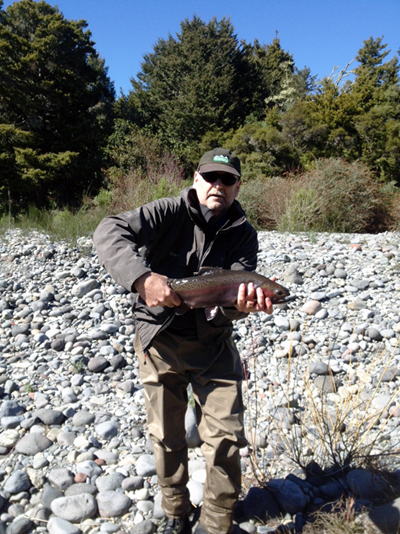 '
'Pumice.
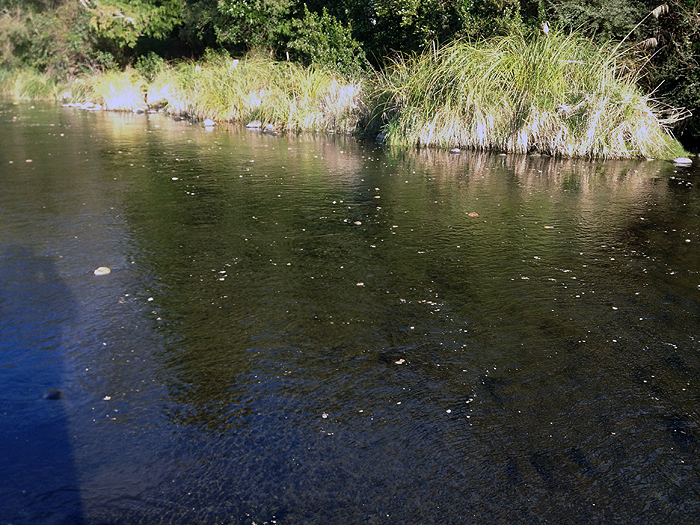 '
'Another rainbow.
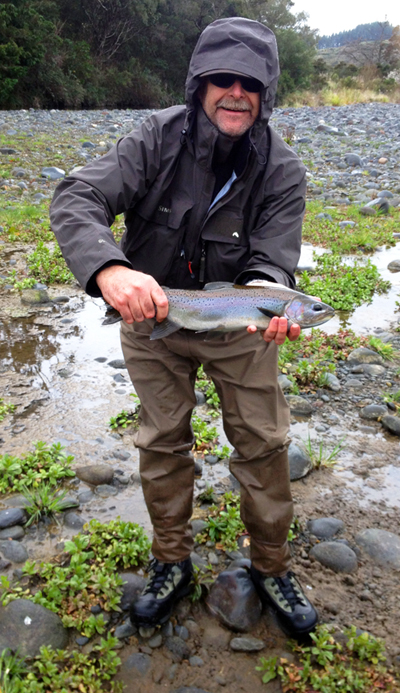 '
'Bridge Pool.
 '
'Flies.
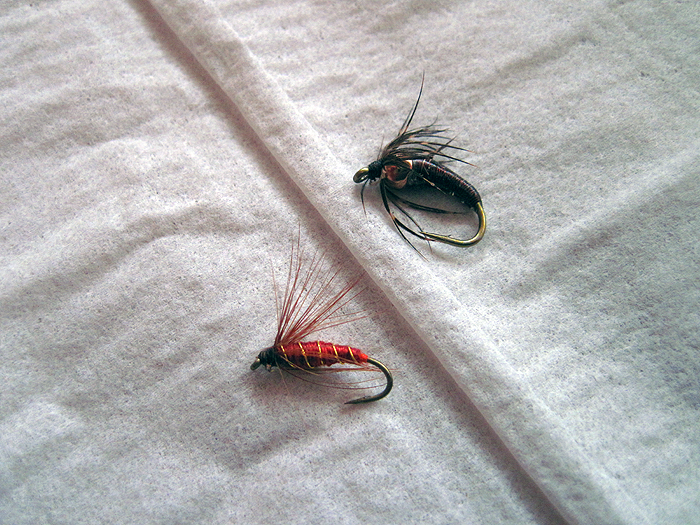 '
'